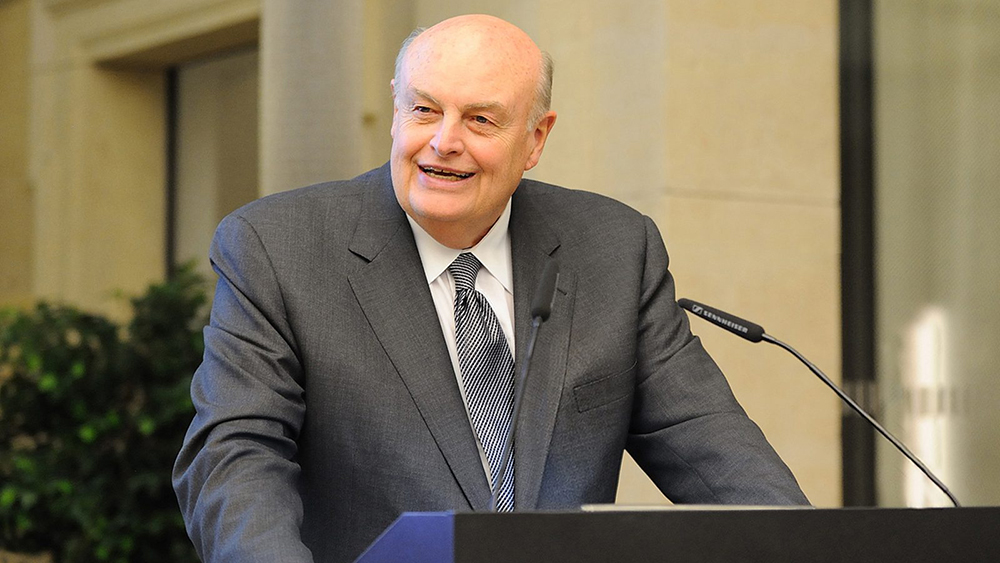
Andreas Franke for the Charles Stewart Mott Foundation
William S. White, addressing the European Foundation Centre in 2009.
William S. White, who died this month, is remembered by after-school advocates as the philanthropist who punched up a little after-school program that so easily could have died, but instead grew to serve 1.7 million children annually across the country.
White’s colleagues like to tell the tale of a famous meeting at the White House — some say in a restroom — that stood the after-school initiative on its feet.
White led the Charles Stewart Mott Foundation for many years, serving as president, chief administrative officer, CEO and chairman of the board. One of the foundation’s longtime funding priorities has been to expand learning opportunities for children after school.
But back in 1997, the needs of children after school were just beginning to be addressed nationally. In the preceding decades women had moved into the labor force in record numbers. In 1996, welfare reform was about to push several million more mothers into the workforce. Concern was growing that the hours after school were a prime time for juvenile crime. But academic research was also showing how kids’ positive development could be promoted.
Fill empty schoolhouses
A new idea had been introduced and approved by Congress in 1994. Use rural and inner-city schools as community learning centers after 3 p.m. The buildings were just sitting there empty in the afternoons. They could provide educational, cultural and social services to children and adults. That year, Congress authorized $25 million for the project known as 21st Century Community Learning Centers.
It was an idea Bill White supported. But only $750,000 ended up being appropriated and the political climate was shifting, with federal spending becoming an issue in a newly Republican-led Congress. There were even proposals to get rid of the Department of Education.
When President Bill Clinton and First Lady Hillary Clinton hosted a White House Conference on Child Care in October 1997, White was there.
So was U.S. Education Secretary Richard Riley and Terry K. Peterson, then an Education Department advisor.
As Peterson recalls it, White came up to Riley and said: “I hear you’ve been working on a proposal … We would really like to invest in all the infrastructure it takes.” On the spot, he offered major support. The Mott Foundation provided a $2 million grant and $55 million multiyear commitment for the 21st Century program.
“It all happened in a five-minute conversation,” Peterson said. Big dollar commitments almost never happen that way, he said.
Priming the pump
The Mott funding offered by White encouraged President Clinton to ramp up his support for the program, according to education researcher Sarah Fierberg Phillips.
Peterson said that, at the time, the pilot 21st Century project was underway in fewer than 10 schools.
“A lot of pilot programs never go anywhere,” he said. They fail for lack of infrastructure such as technical assistance, training, leadership development and identification of best practices.
But in this origin story, the Mott Foundation funding offered by White was the seed that kept after-school opportunities for low-income kids alive.
“The goal of high-quality programs is to offer low-income students the kinds
of opportunities that are available mainly to middle- and upper-class children,” White wrote in the foundation’s 2011 annual report.
The start of a partnership
As Jodi Grant, executive director of the Afterschool Alliance, described it:
“A handshake between White and U.S. Education Secretary Dick Riley led to the establishment of this incredibly successful partnership, which has provided tools, resources, and opportunities to tens of millions of kids through the 21st Century Community Learning Centers (21st CCLC) program. “
Congress appropriated $200 million in 1999, growing to nearly $850 million in 2001. Funding grew even more under President George W. Bush.
Today the 21st Century program has a wide reach. It supports 9,592 centers in schools and community organizations across the country, with federal funding at $1.2 billion.
Among philanthropies, the Mott Foundation has not been alone in championing after-school programs. Early on, the Wallace Foundation and the Open Society Foundations recognized the changing needs that after-school programs could meet and began their support.
Mott increased its investment and went on to fund an advocacy nonprofit, the Afterschool Alliance, It began funding an after-school network in nine states in 2002, expanding into 50 states by 2015.
“My gut instinct always has told me that if you can educate, enrich, mentor and protect children during out-of-school hours, they have a better chance of having positive life outcomes,” White wrote in the Mott Foundation 2011 annual report.































